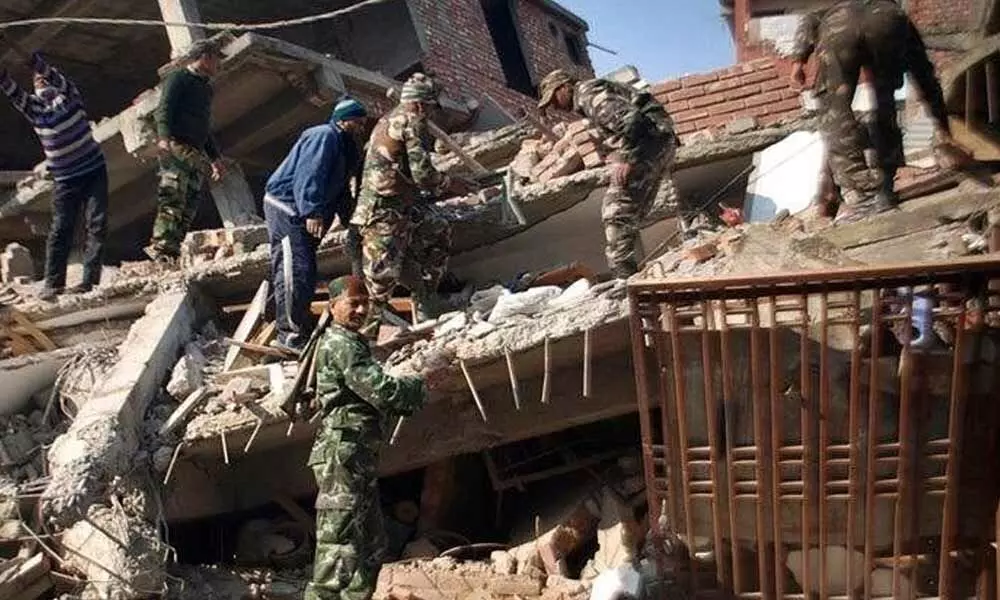IIT Madras comes up with new approach to accurately detect seismic activity

IIT Madras comes up with new approach to accurately detect seismic activity
Researchers at the Indian Institute of Technology (IIT) Madras have developed a new approach to accurately detect earthquakes and launch measures within 30 seconds to 2 minutes after picking up the initial warning signals to save precious human lives and property.
Chennai: Researchers at the Indian Institute of Technology (IIT) Madras have developed a new approach to accurately detect earthquakes and launch measures within 30 seconds to 2 minutes after picking up the initial warning signals to save precious human lives and property.
This lead time, though appearing minute, is sufficient to shut nuclear reactors, transportations like metros or even elevators in high-rise buildings to save countless human lives, they claimed on Thursday. The approach could also be precisely utilised to detect faults and isolation in other domains, they asserted.
"Information of P-wave arrival is crucial in determining other source parameters of the event such as magnitude, depth and epicentre location. Therefore, a solution to the P-wave detection problem that is robust, accurate and precise is essential in order to estimate the event details correctly and to reduce the damage caused by the earthquake or other triggered events," says Kanchan Aggarwal, PhD scholar, IIT, Madras who undertook the research under the guidance of Prof Arun K Tangirala, Department of Chemical Engineering of the premier institute.
Highlighting the practical applications of this research, partially funded by the Board of Research in Nuclear Sciences, an advisory body of the Department of Atomic Energy, Prof Tangirala said the proposed framework is not necessarily limited to the detection of seismic events but is generic and can be used for fault detection and isolation in other domains as well.
"Furthermore, the framework can incorporate any predictive models including the Machine Learning and Deep Learning models, which will reduce the human intervention in the detection," Tangirala, an expert in time-series analysis, multi-scale analysis of signals, system identification and estimation theory among others areas, says.
The findings of their research were published in the open access scientific journals PLOS ONE. The proposed approach brings a diverse set of capabilities in accurately detecting and the P-wave onset, especially in low signal-to-noise ratio (SNR) conditions that all the existing methods fail to attain.
The unique aspects of this novel solution approach as compared with the existing approaches are that it is commensurate with the noise characteristics resulting in minimal sensitivity to outliers or robust detection, offers a more flexible frequency band selection, by decomposing both lower and higher frequencies in each level, resulting in accurate detection, a release said.
It allows the user to discard the noise in undesired time-frequency bands resulting in improved SNR. Thereby resulting in accurate picking of P-wave onset. The work proposes a novel real-time automatic P-wave detector and picker in the prediction framework with a time-frequency localisation feature.
This approach is not necessarily limited to the detection of seismic events but is rather generic in that it can be used for fault detection in other domains as well, the release added. Another positive offshoot of the proposed framework is that it facilitates P-wave reconstruction once it has been detected.
This aspect has not been explored by peers. "The ground is continuously at unrest mainly due to waves in the ocean, changes in the earth's crust, atmospheric variations and human activities," it added. Seismic signals can be generated from either natural (earthquakes, volcanic eruptions, tsunamis, etc.) or man-made (heavy traffic, nuclear explosions, mining activity, etc.) sources. Regardless of the source, all seismic events release energy proportional to their scale.
This released energy moves out in all directions as a wave and is recorded as a seismic signal by a seismometer. Seismograms are recordings of ground vibratory motion obtained from a seismometer. Analysis of these seismograms is vital to understanding earth's activity and in setting up early warning systems for earthquakes, determining the source locations and detecting the source of other seismic events.
Detecting or predicting the damaging part of an earthquake holds great value in protecting lives and preventing loss of property, they said.














